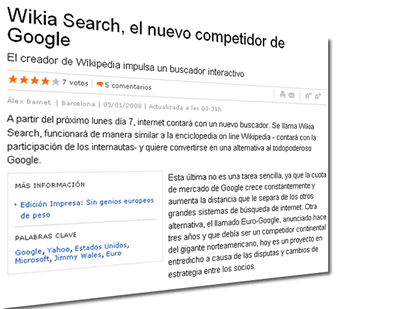Appearing on Google’s 1 – 10 web results is every web administrator’s dream. With Google generating over 85% of all Internet search engine referred traffic, reaching that privileged ranking can differentiate the professional Internet players from the amateur website owners. As a matter of fact, numerous tests have demonstrated that the top three Google results are read by the majority of web surfers, the remaining results on that first page are the second most efficient ones, but only about 10% of Internet users explore beyond the third page of results.
In other words, if your company is not part of the elite, or the top 30 results, the probability of being contacted by a client becomes almost non-existent. Thirty spots are all you have. And only ten of them are reserved for the cream of the crop. Is this truly all the space that is available for everyone around the globe? In reality, there are several factors that make those top rankings that you so feverishly compete for less contended than they first appear. The answer lies in the segmentation and accurate identification of your market niche along with an effective positioning of your website for this niche.
For now, you may want to temporarily forget about the Internet and start by asking yourself how many competitors you have in the real world. Or, if you prefer, you may want to list those businesses that are offering a product or service portfolio resembling yours and targeting the same client segment that you are profiting from. It is entirely possible that you may have already gone the extra mile differentiating your product or service offering, finding a market niche that can be addressed in a unique way, or identifying some other competitive advantage of your own. In other words, you may already be competing with a reduced number of firms, probably less than 30, and perhaps even less than 10. If this is what your real world looks like, why should it be any different on the Internet? Even if we accept the fact that there will always be markets or segments that will attract a greater number of competitors, as long as we have accurately segmented our piece of the pie, we will frequently find that only a handful of competitors are vying for our same portion.
Let’s look at this issue now from an Internet perspective. Can we all fit in Google’s top 10 results? The answer is a definite yes, at least as it applies to those results generated by search terms that potential clients use when looking for companies like yours. The good news is that Google has reserved for your business a small number of pages where your website can appear on the top three results, and then, a handful more where your site will definitely rank among the elite, but where, unfortunately, you will also contend alongside your closest competitors. Therefore, constantly measuring and tracking the amount of traffic that a site experiences does not seem as important -after all, in a real shop, one is more interested in helping customers than visitors. Instead, you should concentrate in assuring that when potential Internet clients look for your products or services they can indeed find your website. Let’s see how this is done.
1. Accurately identifying your market niche
You must get to know the type of clients that you are addressing: who they are, where they are located, and how they look for your products or services. Keep in mind that the typical Internet user begins a search using very broad terms. For example, someone in Great Britain looking for homes in the Costa Blanca of Spain may enter “houses in Spain” as search terms. However, those same keywords could be used by a student who is interested in Spanish architecture, or by a person looking for rental property in Madrid, or by an economist who wants to know how real estate prices have recently faired in Spain.
When a search engine returns an unmanageable number of results, users typically restrict their next search by including more specific criteria. For example, they may limit the geographic coverage -“house in Costa Blanca”-, include the type of product –“townhouse in Costa Blanca”-, or add an action –“opportunities + townhouse in Costa Blanca for sale”. If your business happened to be a small real estate agency in the town of Javea -in the Costa Blanca of Spain-, a potential client of yours would probably belong to the profile of those that entered “opportunities + townhouse in Costa Blanca for sale.”
Nowadays, a great majority of Internet searches are conducted by entering concepts consisting of two or three words. However, after a user becomes more familiar with Internet search engine technology the tendency is to type in more specific and detailed phrases.
2. Identifying your keyword sets
Are you targeting a general English speaking audience or perhaps Scandinavian customers that may be interested in buying luxury homes in Javea? One of your first criteria should therefore be the language.
After a language is selected, you must figure out how potential clients will look for your website. Keep in mind though that if you are a small real estate agency in Javea, focused in selling local properties to a British market, for example, it will be extremely difficult for your website to appear as part of the elite results when someone simply types in “real estate in Spain” as the search criteria. At the same time, be aware that the chances of your small business capturing a customer that entered those terms in Google are much reduced. The problem is that “real estate in Spain” is not the space where your small local company should be competing in. If, on the other hand, you had correctly identified your market niche, you would be enjoying a definite advantage when users entered more specific terms, such as “townhouses in Javea”, “villas in Javea”, “apartments for sale in Javea”, or “real estate agents in Javea”. In summary, the keywords that we select must always identify very clearly our specific market niche.
3. Optimizing your website
Your next step will be to ensure that the contents of your website reflect precisely the products or services that your clients are looking for.
If you are wondering how search engines classify websites, you must bear in mind that after all, a website is nothing more than information. Books have been organizing and presenting information for centuries. If you were handed a book and asked what the book was about, you would probably first look at its title, subtitles or any other text on the book’s cover. Next, you might turn the book over and look for a summary or synopsis on its back. A third level of information could be derived from looking at its index. Finally, and without having to read the entire book, you would browse through some of the pages, where individual chapter and section titles would catch your attention. If you were considering buying the book, you would probably take a look at recommendations from prior readers, paying more attention to those that you consider experts in the field.
Google is no different. When it comes to classifying a website, Google will look at the title of the default page, at its description or subtitle, and at the contents inside the page itself, which if properly built, should be a synopsis of what the users will find in the website. Google will next evaluate the website’s navigation or indexing by traversing through the various links inside each page or chapter. While Google navigates through a website, it will repeat the process of looking at the title, description and contents of each and every page.
In the same manner as we use recommendations from prior consumers before making a purchasing decision, Google will also take into account those links that point to your pages from external websites. And, the more important and prestigious those external referring sites are, the higher your own website will be rated by Google.
It is therefore extremely important to have a good title and description for our website’s home page, but it is equally important to make sure that the titles and descriptions for the remaining pages accurately reflect their contents (nobody wants to read a book whose chapter titles are all the same). It goes without saying -unless your company name is Coca-Cola or Nike- that you should not use the name of your business as a page title. If someone already knew your company by name, they probably would know your web address as well.
4. Learning from your clients
You should review from time to time your website’s traffic statistics and derive from them those search engines and search terms that have primarily been used to find your website. At the same time, this information will identify those keywords most often entered by your potential clients. If you then create new pages using these same concepts and look for partners willing to include in their websites a referral link to your home page, you will start noticing a progressive improvement of your website’s ranking, at least for those searches that deliver the most profitable results.
Conclusion
In your race to become a highly ranked website, do not try to compete using very broad terms. Your site can join a search engine’s elite (top 30 results), or even be part of its cream of the crop (top 10 results), if you identify and segment your market niche accurately. In fact, even though you may end up registering less Internet traffic than before, or less than your competitors, the ratio between the number of visitors that simply pass through your site and the number of potential clients, also known as the customer conversion ratio, will be much higher. After all, what are you most interested in, traffic or clients?
 Al hilo del lanzamiento de Wikia Search, La Vanguardia me cita en un artículo que publicaba el pasado sábado el diario catalán. Su autor, Alex Barnet, se había puesto en contacto conmigo para conocer mi opinión sobre la posibilidad de que pudiera surgir en Europa una alternativa a Google, y el avance de los proyectos que se están desarrollando en este sentido.
Al hilo del lanzamiento de Wikia Search, La Vanguardia me cita en un artículo que publicaba el pasado sábado el diario catalán. Su autor, Alex Barnet, se había puesto en contacto conmigo para conocer mi opinión sobre la posibilidad de que pudiera surgir en Europa una alternativa a Google, y el avance de los proyectos que se están desarrollando en este sentido.